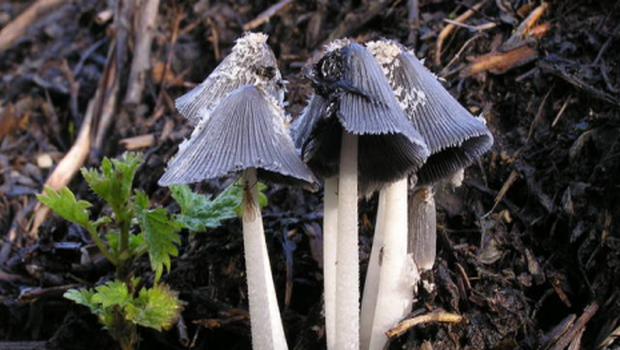New Antibiotic Found in Mushroom That Grows on Horse Dung
Microbiologists and molecular biologists at ETH Zurich and the University of Bonn have discovered a new agent in fungi that kills bacteria. The substance, known as copsin, has the same effect as traditional antibiotics, but belongs to a different class of biochemical substances. Copsin is a protein, whereas traditional antibiotics are often non-protein organic compounds.


Scientists have isolated the new active compound from the grey shag that grows on horse dung. (Photo by Andreas Gminder/mushroomobserver.org /CC BY-NC-SA 3)
Microbiologists and molecular biologists at ETH Zurich and the University of Bonn have discovered a new agent in fungi that kills bacteria. The substance, known as copsin, has the same effect as traditional antibiotics, but belongs to a different class of biochemical substances. Copsin is a protein, whereas traditional antibiotics are often non-protein organic compounds.
The researchers led by Markus Aebi, professor of mycology, discovered the substance in the common inky cap mushroom Coprinopsis cinerea that grows on horse dung. When they began their research, the scientists were interested in understanding how this fungus and various bacteria affect each other's growth. This involved cultivating the fungus in a laboratory along with several different types of bacteria. It was found that C. cinerea is able to kill certain bacteria. Further research demonstrated that the copsin produced by the mushroom is responsible for this antibiotic effect.
Copsin belongs to the group of defensins, a class of small proteins produced by many organisms to combat microorganisms that cause disease. The human body also produces defensins to protect itself against infections. They have been found, for example, on the skin and in the mucous membranes.
For Aebi, the main focus of this research project was not primarily on applications for the new substance. “Whether copsin will one day be used as an antibiotic in medicine remains to be seen. This is by no means certain, but it cannot be ruled out either,” he says.
The ETH professor is much more intrigued by fundamental questions, such as how fungi have used defensins and other naturally antibiotic substances for millions of years to protect themselves against bacteria. Why does this work for fungi while humans have been using antibiotics in medicine for just 70 years with many of them already becoming useless due to resistance? “Fungi have internal instructions on how to use these substances without resulting in selection of resistant bacteria. How to decode these instructions is an intriguing problem for basic research,” explains Aebi.
Andreas Essig, a postdoc in Aebi's group and lead author of the study, is currently exploring potential applications for copsin that has been registered for patent approval. It was the biochemical properties of the substance that led the scientist to do so. “Copsin is an exceptionally stable protein,” says Essig. Proteins are generally susceptible to protein-degrading enzymes and high temperatures. Copsin is an exception because it also remains stable when heated to a temperature of 100 degrees Celsius for several hours or when subjected to protein-degrading enzymes. The researchers believe that the protein has these properties because of its extremely compact three-dimensional structure, as NMR spectroscopy has shown.
The ETH researchers were also able to unravel the exact mechanism of action, discovering that copsin can bind to lipid II, an essential building block for the cell wall of bacteria. “Building the cell wall is the Achilles heel of bacteria,” explains Essig. If copsin binds to lipid II, the bacteria die because they are unable to build new cell wall.
In addition to being used as an antibiotic in medicine, it may also be possible to use copsin in the food industry as well. This is because copsin kills many pathogens including Listeria, a type of bacteria that can cause severe food poisoning and is therefore feared, especially in the production of non-heat treated foodstuffs such as raw milk cheeses and dried meats.
Reference: Essig A, Hofmann D, Münch D, Gayathri S, Künzler M, Kallio PT, Sahl HG, Wider G, Schneider T, Aebi M: Copsin, a novel peptide-based fungal antibiotic interfering with the peptidoglycan synthesis. Journal of Biological Chemistry, online publication Oct. 23, 2014.
Source: ETH Zurich
ASRA Pain Medicine Releases Groundbreaking Infection Control Guidelines for Pain Management
January 22nd 2025The American Society of Regional Anesthesia and Pain Medicine (ASRA Pain Medicine) released comprehensive infection control guidelines for pain procedures, emphasizing prevention, early recognition, multidisciplinary collaboration, and judicious antibiotic use to enhance patient safety and healthcare outcomes.
Reflecting on the US Withdrawal from the World Health Organization
January 21st 2025An infection preventionist reels from the US exit from WHO, writing that it disrupts global health efforts, weakens infection control, and lacks research funding and support for low-income nations dependent on WHO for health care resources.
Infections Do Not Recognize International Borders: The Potential Impact of US Withdrawal From WHO
January 21st 2025The US withdrawal from WHO jeopardizes infection prevention, research funding, and global collaboration, disproportionately impacting low-income nations reliant on WHO support for equitable health care advancements.